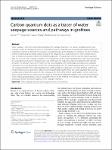Item Infomation
Full metadata record
| DC Field | Value | Language |
|---|---|---|
| dc.contributor.author | Sun, Bo | - |
| dc.contributor.author | Ma, Fenyan | - |
| dc.contributor.author | Zhang, Huyuan | - |
| dc.date.accessioned | 2023-10-06T08:21:32Z | - |
| dc.date.available | 2023-10-06T08:21:32Z | - |
| dc.date.issued | 2023 | - |
| dc.identifier.uri | https://link.springer.com/article/10.1186/s40494-023-01058-4 | - |
| dc.identifier.uri | https://dlib.phenikaa-uni.edu.vn/handle/PNK/9495 | - |
| dc.description | Cc-BY | vi |
| dc.description.abstract | Water seepage is one of the main factors leading to the damage of grottoes. The sources and pathways of water seepage need to be identified to relieve it. Although the sources and pathways are investigated using geophysical exploration methods commonly, the results are unsatisfactory due to the limitation of resolution. The tracer method has been widely used to examine water seepage in the natural sciences and engineering. However, most tracers have an impact on grottoes, making this method inapplicable. This study was the first to use the carbon quantum dots as a tracer of water seepage in grottoes. The characteristics of the carbon quantum dots, which was synthesized by various biomass precursors through large-scale synthesis in the field, were analyzed to determine the optimal precursor. The structure, fluorescence intensity, and water solubility of the carbon quantum dots were evaluated. Laboratory tests were designed to examine the transport properties of the carbon quantum dots in rocks and cracks. | vi |
| dc.language.iso | en | vi |
| dc.publisher | Springer | vi |
| dc.subject | Carbon quantum dots | vi |
| dc.subject | grottoes | vi |
| dc.title | Carbon quantum dots as a tracer of water seepage sources and pathways in grottoes | vi |
| dc.type | Book | vi |
| Appears in Collections | ||
| OER - Khoa học Vật liệu, Ứng dụng | ||
Files in This Item:

